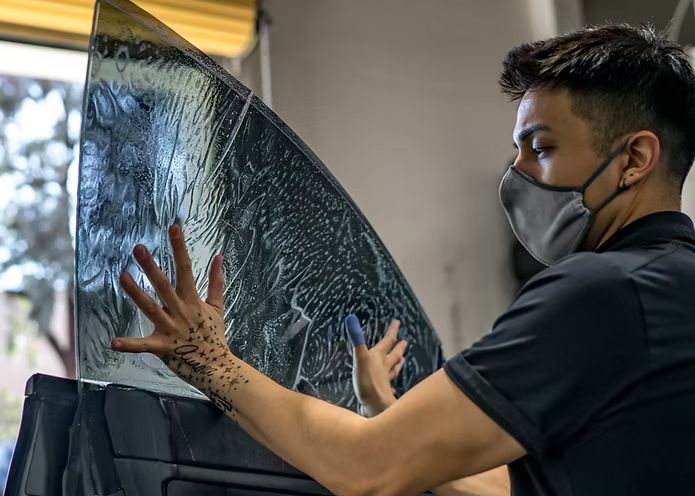Automotive Window Tinting: Improve Your Car’s Look and Performance

Window tinting for automobiles has become a popular modification among car enthusiasts and everyday drivers alike. It offers both aesthetic and functional benefits, improving the overall appearance of your car while enhancing its performance in several key areas. Whether you’re looking to elevate the style of your ride, protect your interior, or make your driving experience more comfortable, automotive window tinting, Chatsworth provides a wide range of advantages. In this article, we’ll explore the various benefits of automotive window tinting, the types of films available, and considerations to keep in mind when getting your car windows tinted.
What Is Automotive Window Tinting?
Automotive window tinting refers to the process of applying a thin film to the windows of a car. The film is typically made of polyester and is coated with a layer of metal, ceramic, or dyed materials. The purpose of tinting is to reduce the amount of light that passes through the glass, which offers numerous benefits, from enhancing privacy to blocking harmful UV rays.
Window tinting can be applied to various parts of the vehicle, including the side windows, rear windshield, and front windshield. The level of tint applied can vary, depending on the laws in your region and your personal preferences.
Types of Window Tinting Films
There are several types of window tinting films available, each with distinct characteristics and benefits. Understanding these options will help you choose the best one for your car:
1. Dyed Window Tint
Dyed window tinting is one of the most common and affordable options. It involves applying a layer of dye between two layers of polyester film. The dye absorbs sunlight, reducing glare and heat. While it is effective at blocking UV rays and providing privacy, it may fade over time and offer less heat rejection compared to other types of films.
2. Metalized Window Tint
Metalized window tint films contain tiny metallic particles that reflect heat and sunlight away from the car. These tints provide excellent heat rejection and are more durable than dyed films. However, the metal content can interfere with GPS, radio, and satellite signals, which is something to keep in mind if you rely on these technologies.
3. Ceramic Window Tint
Ceramic window tinting is one of the most advanced options available. It uses non-metallic, ceramic particles to block heat and UV rays. Ceramic films provide excellent visibility, superior heat rejection, and greater durability without interfering with electronics. While ceramic films tend to be more expensive than dyed or metalized options, they offer superior performance and longevity.
4. Hybrid Window Tint
Hybrid window tinting combines the benefits of dyed and metalized films. It provides the aesthetic appeal of dyed films while offering the heat rejection properties of metalized films. This type of film strikes a balance between cost and performance, making it a popular choice for many drivers.
Benefits of Automotive Window Tinting
Automotive window tinting is more than just a cosmetic enhancement—it comes with a host of practical benefits that can improve your car’s performance, safety, and longevity.
1. Enhanced Aesthetic Appeal
One of the most immediate benefits of window tinting is its impact on your car’s appearance. Tinted windows provide a sleek, modern look that gives your vehicle a more polished and sophisticated aesthetic. Whether you drive a luxury car or an everyday vehicle, tinted windows can instantly upgrade the exterior design and make your car stand out on the road.
2. UV Ray Protection
Prolonged exposure to UV rays can cause a range of issues, including skin damage, fading upholstery, and weakening of the car’s interior materials. High-quality window tinting films can block up to 99% of harmful UV rays, reducing the risk of sunburn and protecting your car’s interior from sun damage. This is especially beneficial if you live in regions with high sun exposure.
3. Improved Privacy and Security
Tinted windows provide increased privacy for both you and your passengers. The darker glass makes it more difficult for others to see inside your car, providing a greater sense of security when your vehicle is parked in public spaces. This added privacy can also deter theft, as thieves are less likely to break into a car when they can’t easily see what’s inside.
4. Heat Rejection and Comfort
One of the primary reasons people choose to tint their car windows is to reduce the heat that enters the cabin. Window tinting can block a significant amount of solar heat, making your car’s interior cooler on hot days. This is particularly beneficial in areas with hot climates, as it reduces the need for air conditioning, improving fuel efficiency and comfort for the driver and passengers.
5. Glare Reduction
Driving during certain times of the day can expose you to intense sunlight, creating glare that obstructs your visibility. Tinted windows help to reduce glare, providing a clearer view of the road and enhancing safety. This is especially important for long road trips or commuting during sunrise and sunset hours.
6. Interior Protection
Excessive sun exposure can cause the materials inside your car—such as the dashboard, seats, and carpeting—to degrade over time. Tinted windows reduce the amount of sunlight that enters the cabin, protecting these surfaces from fading, cracking, or warping. This can help maintain the overall look and value of your vehicle for longer.
Legal Considerations and Choosing the Right Tint
Before getting your car windows tinted, it’s important to familiarize yourself with the local laws and regulations regarding window tinting. Different states, regions, and countries have varying legal limits on how dark your tint can be, especially for front windows and windshields. Failure to comply with these laws can result in fines or the need to remove the tint altogether.
Choosing the Right Tint for Your Needs
When selecting a tint, consider your primary goals. If your primary concern is heat rejection and UV protection, a ceramic or metalized tint may be your best option. If you’re on a budget and prefer a simple, aesthetic upgrade, a dyed or hybrid tint may suit your needs. Always consult with a professional tint installer to ensure you choose the best film for your car and driving conditions.
Conclusion
Automotive window tinting is a worthwhile investment for car owners who want to enhance their vehicle’s appearance and performance. Whether you’re looking to protect your car’s interior, increase privacy, or reduce heat and glare, there’s a tinting option available to meet your needs. With a variety of films to choose from and a host of benefits, automotive window tinting can significantly improve your driving experience, making it more comfortable, stylish, and secure.



